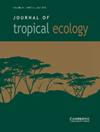Plant community and native primate as drivers of habitat use by an exotic primate (Saimiri spp. Linnaeus, 1758) in an Atlantic Forest fragment
IF 1
4区 环境科学与生态学
Q4 ECOLOGY
引用次数: 0
Abstract
Understanding how and why exotic species use their habitats is crucial for defining effective conservation strategies. We aimed to investigate habitat use by an exotic population of squirrel monkeys living in an Atlantic Forest fragment and identify factors associated with their habitat preferences. Over 6 months of scan sampling observations, we collected data on native and exotic plants consumed by the squirrel monkeys, food availability, and interactions between the squirrel monkeys and the native common marmosets. We also georeferenced the estimated centroid point of the study group during each scan. Squirrel monkeys used Secondary Old Forest habitats more often than the other habitats available. The consumption of native and exotic plants and the association with common marmoset appear to have influenced the habitat use of the exotic squirrel monkeys; however, the choice habitat did not demonstrate to be associated with food availability. The exotic squirrel monkeys preferred to use less disturbed habitats to consume a high amount of food (often associated with the common marmoset), potentially optimizing their food intake. Our findings demonstrated the adaptive success of an exotic primate in its non-natural habitat and the key role of the plant community in maintaining this population.植物群落和本地灵长类动物是大西洋森林碎片中外来灵长类动物(Saimiri spp.Linnaeus,1758)栖息地使用的驱动因素
了解外来物种如何以及为什么使用它们的栖息地对于制定有效的保护策略至关重要。我们旨在调查生活在大西洋森林碎片中的松鼠猴外来种群的栖息地使用情况,并确定与它们的栖息地偏好相关的因素。在6个月的扫描采样观察中,我们收集了关于松鼠猴食用的本地和外来植物、食物可用性以及松鼠猴和本地普通狨猴之间的相互作用的数据。我们还在每次扫描期间对研究组的估计质心点进行了地理参考。松鼠猴比其他可用的栖息地更经常使用次生林栖息地。当地和外来植物的消费以及与普通狨猴的联系似乎影响了外来松鼠猴的栖息地使用;然而,选择栖息地并没有被证明与食物供应有关。外来的松鼠猴更喜欢使用干扰较小的栖息地来消耗大量食物(通常与普通狨猴有关),这可能会优化它们的食物摄入。我们的发现证明了外来灵长类动物在其非自然栖息地的适应性成功,以及植物群落在维持该种群中的关键作用。
本文章由计算机程序翻译,如有差异,请以英文原文为准。
求助全文
约1分钟内获得全文
求助全文
来源期刊

Journal of Tropical Ecology
环境科学-生态学
CiteScore
2.10
自引率
0.00%
发文量
44
审稿时长
18-36 weeks
期刊介绍:
Journal of Tropical Ecology aims to address topics of general relevance and significance to tropical ecology. This includes sub-disciplines of ecology, such as conservation biology, evolutionary ecology, marine ecology, microbial ecology, molecular ecology, quantitative ecology, etc. Studies in the field of tropical medicine, specifically where it involves ecological surroundings (e.g., zoonotic or vector-borne disease ecology), are also suitable. We also welcome methods papers, provided that the techniques are well-described and are of broad general utility.
Please keep in mind that studies focused on specific geographic regions or on particular taxa will be better suited to more specialist journals. In order to help the editors make their decision, in your cover letter please address the specific hypothesis your study addresses, and how the results will interest the broad field of tropical ecology. While we will consider purely descriptive studies of outstanding general interest, the case for them should be made in the cover letter.
 求助内容:
求助内容: 应助结果提醒方式:
应助结果提醒方式:


